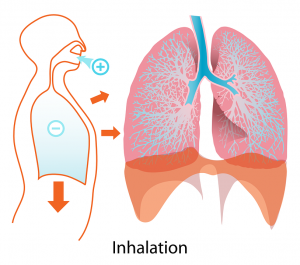Why do we need to control our Inhale and Exhale?
 I did a lot of self discovery in college, especially when I traveled abroad. But I never took a moment to sit and appreciate what was happening in my life. Now, all I can do is think. And I’ve been thinking a whole lot.
I did a lot of self discovery in college, especially when I traveled abroad. But I never took a moment to sit and appreciate what was happening in my life. Now, all I can do is think. And I’ve been thinking a whole lot.
Controlling how and when you inhale and exhale can pump up your fitness and bring you bliss.
In yoga, indoor-cycling, and boot camp classes, we constantly hear about the importance of bringing oxygen to our muscles and the potential of increasing our lung capacity. Suddenly people like me have found ourselves focusing on, even worrying about, our breathing, something our body has been quietly taking care of since the day we emerged from the womb gasping.
Yet most of us, including instructors, don’t know a lot about this basic bodily function. For instance, the level of oxygen in our blood doesn’t have much room to rise, no matter how deeply we might breathe (blood is like a sponge that’s always about 98 percent soaked). And when we breathe hard during exercise, it’s not because our lungs need more oxygen but mostly because we need to exhale carbon dioxide, which builds up in our exhausted muscles. As for increasing lung capacity, exercise has never been shown to do that, although competitive swimmers and other elite athletes usually have larger lungs.
Read on for more surprising facts and to find out what paying attention to your breath can do for your body and mind.
Don’t Get Winded
The good news is you don’t need to obsess about your breath when you work out. “Our bodies are phenomenal at keeping oxygen and other gases at just the level they should be,” says Jerome Dempsey, Ph.D., the director of the pulmonary medicine lab at the University of Wisconsin School of Medicine and Public Health in Madison. When we exercise, our brain directs us to breathe more rapidly or to start breathing through our mouths, and this happens without our having to think about it.
Still, there are ways to breathe better during your workout. Try these strategies, tailored to your routine.
Experts generally recommend exhaling when you lift and inhaling when you lower. That will prevent you from holding your breath, “which can elevate your blood pressure dramatically,” explains Aimee Layton, Ph.D., an exercise physiologist at Columbia University Medical Center. “When you lower the weight, your blood pressure drops quickly and you can become dizzy or pass out.”
Running
Many seasoned runners report that slow, deep breathing makes for a more enjoyable run. That’s most likely because it triggers the relaxation response and helps the brain and body stay loose, according to Layton. “But when you reach the point where you’re really pushing it, like on a hill or in a sprint, your breathing will become more shallow and rapid, because that’s what your body is demanding,” she says.
Swimming
The key to efficient breathing when you swim is to begin exhaling through your nose or mouth as soon as you finish breathing in. “Instead, beginners often hold their breath while their face is in the water, then try to exhale and inhale quickly when they turn their head,” says Marty Gaal, the head coach for One Step Beyond Multisport Coaching in Cary, North Carolina. This leads to shallow breathing and a low supply of oxygen, which will eventually force you to stop or roll over in order to take a few good, deep breaths. “You need to force the rhythm a bit,” Gaal says. “There’s no pausing when it comes to breath; it’s constant.”
Yoga
Wondering what the heck the instructor means by “ujjayi breathing”? It’s basic slow breathing with a twist: You narrow the back of your throat to make a buzzing sound each time you inhale and exhale. That provides a mantralike focus that will keep you from worrying — about the pile of work on your desk or the mound of laundry that needs to be done — when you should be relaxing. Many experienced practitioners swear by it. “Whether breathing’s effects are psychological, physiological, or a placebo, I see a difference in my clients’ flexibility and overall success when breath is used correctly in yoga”.
High-Altitude Activity
Feeling breathless and weak while hiking, running, or skiing at a high altitude usually means that your lungs are having a hard time keeping up with your body’s demand for oxygen, which is harder to come by in thin air. So take it slowly. Give your body a day (or more if you’ll be above 8,000 to 12,000 feet) to acclimate before exerting yourself. Then ease into it gradually.
Boost Your Bliss
How we breathe can rev up or calm our autonomic nervous system, which controls our heartbeat, the release of hormones, and other vital functions. “This is essentially what makes yoga breathing effective,” says Erica Wehrwein, Ph.D., an assistant professor of physiology at Michigan State University in East Lansing. Give these two breaths a try when you need to chill or motivate.
Basic slow breathing: The regular practice of deep, controlled breathing causes our stress-hormone levels to decline and our metabolic rate to slow. The result: a temporary sense of calm and well-being. Start in a seated, relaxed position — say, on the floor or in a desk chair. Exhale completely, then slowly count to five as you inhale through your nose, imagining that you’re pulling air deep into your lungs and belly. With your lungs fully inflated, hold your breath for a second or two, then count to five as you slowly exhale through your nose. Pause for a second or two when your lungs are empty, then start the process again, continuing for five to 10 minutes. You should feel noticeably more relaxed.
Right-nostril breathing: Skip the coffee when you’re feeling sluggish and do a round of this energizing breathing for a quick pick-me-up. While comfortably seated, close off your left nostril with your left thumb. Inhale and exhale through your right nostril for three to five minutes. Research shows that right-nostril breathing can elevate blood pressure, which can make us feel a grande dose of natural invigoration. (On the flip side, doing left-nostril breathing lowers blood pressure and can produce a calming effect.)
Dirty-AirAlert
Pollution not only causes short-term lung irritation and triggers asthma attacks, but there’s also evidence that prolonged exposure to it during exercise can lead to lung damage. “This shouldn’t stop you from exercising outside, but do be smart about where and when you work out,” says Carol Garber, Ph.D., an associate professor of movement sciences at Columbia University. Follow these tips:
Avoid busy roads. Run or bike on side streets when possible; ideally, find a path or park.
Lace up early. Air is generally cleaner in the morning, especially before rush hour.
Check the forecast. Avoid running and biking in the late afternoon on hot days, when harmful ozone levels tend to peak. Go to airnow.gov for your local air-quality report before heading out.
Stay inside if necessary. During heat waves or when the pollution report is grim, hit the treadmill or sign up for a Pilates or barre class. But don’t make yourself crazy. “Even in less-than-perfect air, the benefits of exercise usually outweigh the risks of not exercising at all,” Garber says.
Stay out of any pool with a strong chlorine smell. It’s a sign that the chemical is working hard to neutralize contaminants in the water and that a ton of by-products, which are known to cause lung damageArticle Search, is being released into the air. (Researchers believe that this is why exercise-induced asthma and other breathing problems are more prevalent among swimmers than other athletes.) Indoor pools pose a higher risk because fumes can’t dissipate as easily.
About the Author: Carol James is an EssayLab psychology department writer and senior editor. She has MA degree in social sciences and is an excellent specialist in this field. Carol worked with numerous materials on the subject and is eager to share her knowledge with our readers.
ABOUT THE AUTHOR
I am Muhammad Amjad Butt and working as blogger. I want to share our experience on your website through quality article.

